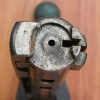And we don't have the spare parts we used to. But the OP's rifle still doesn't fit.
This is true, however extractors aren't hard to find. In a short internet search I found 6 companies that show in stock, and prices from $14.95 to $23.50. Complete bolts as low as $40, stripped bolt bodies from $8 to $30-ish. I bought 5 stripped bolts at a gun show not long ago for $40 or $50 I believe. I believe those prices are far below what a Ruger 77 bolt or related parts cost from the factory, as a comparison. I'm a believer in having basic spare parts around for things I like to shoot. I think I'm set for this and part of the next lifetime for Springfield parts, and don't have much money in any of it.
Yes, parts can break, even using them as they were designed. I replaced the extractor spring in a Colt AR carbine years ago, but it didn't deter me from using it the same way as what likely caused the part failure. I keep a spare around now. Not trying to be a smart aleck, jusy saying, whats the heartburn in using something the way it was designed (by the people that actually
redesigned it for their use), when parts are easily available and very easy to replace? Are we stuck with Mausers original design or his overlooking a benefit? Most bolt action designs today are derived from Mausers design, and virtually all changed aspects of it in some way. All commercial Mausers have beveled extractors from what I understand, it was a common change when sporterizing, and I cant figure out, with quality parts, to single load, why its an issue, or why we would be stuck with late 1900s design without any progress in design or use.
FWIW, I have had a 1903 jam or stick shells in the magazine to the effect that they were slightly below bolt level and wouldn't feed. Knowing I could single load it with no problem if need be is nice, in retrospect. I was hanging out in very good grizzly country. It cleared with little effort, but if I hadn't the luxury of those few moments to figure it out, things could have been different. Ive also had a commercial Mauser in 375 H&H with a magazine problem. No gun is entirely bombproof, and the Mauser action isn't supernatural or perfect as originally designed.
I don't believe theres any rash of broken extractors from single loading, or it wouldn't have been part of original use and training. So they changed use and training, and it was a holdover from earlier designs, that has little bearing on the question. It was made to single load, it was regularly done, part of weapon design/redesign. They seem to take it pretty well overall, parts can be replaced easily and cheaply. Not seeing the problem.





